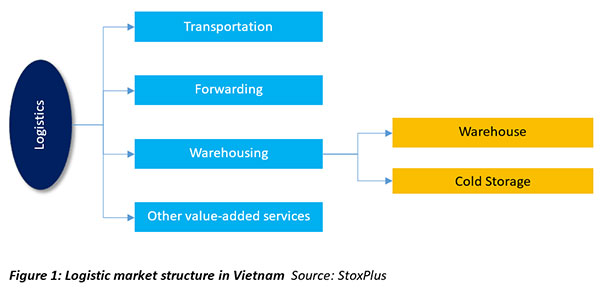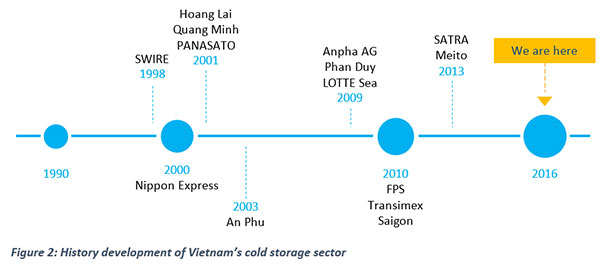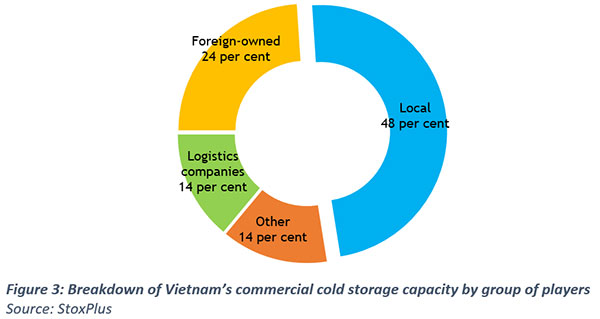Cold storage is classified as climate control logistics which refers to a system controlling the temperate and humidity with the purpose of increasing the storing period for particular categories of goods.

Cold storage can be segmented into three main categories namely deep frozen (-28 – -30°C for storing seafood), frozen (-16 – -20°C for storing meat), and chiller (2 – 4°C for vegetables, fruits and flower).
The cold storage market in Vietnam has a short development history of 20 years. The first commercial cold storage was built in 1996 by Konoike VinaTrans, a logistics joint venture between Konoike transport Co. Ltd (Japan), Vinatrans Co. (Vietnam), Vinalink Co.(Vietnam), and Vinafreight Co. (Vietnam).
Subsequently in 1998, Swire Cold Storage from Australia followed Konoike to build one of the most modern cold storages to date in Vietnam. The market started booming in 2007 with the construction four cold storages in the same year. Hung Vuong built two storages with a total capacity of 40,000

pallets to meet its in-house storage demand as well as to provide storage services for other seafood and retailer companies in the market. Both local and foreign cold storage providers have become interested in the market since then.

As surveyed by StoxPlus, major commercial cold storage providers are mainly situated in the South due to high demand of this region and can be classified into four main groups of players namely local, foreign-owned logistics companies, and others as Figure 3.
Despite of dominating the market in terms of designed capacity, local companies are considered the second tier. The leading local companies are Hoang Lai, Hung Vuong, SATRA, and Phan Duy. Of which, two leading companies, namely Hung Vuong and SATRA were the first to operate cold storage facilities to serve their in-house demand. However, local companies’ cold storages are equipped with standard facilities and simple designs. Some cold storages even do not even have racks for storing.
Meanwhile, foreign-owned group lead the market by leveraging professional management and modern facilities. Established in 1998, SWIRE was one of the first foreign-owned cold storage providers penetrating Vietnam with professional management as well as modern facilities. Other foreign-owned providers are Lotte Sea (2009) and Preferred Freezer Services (2010). Foreign-owned commercial cold storage providers are the market leaders in quality and management services with a diversified portfolio of clients and prime location.

Huge potentials from Vietnam commercial cold storage market According to Vietnam Cold Storage Market 2016 by StoxPlus, cold storage is one of the most potential logistics segment for growing in Vietnam, since Vietnam is an agriculture economy. Few foreign and local companies tapped in this segment and none of them provides the whole chain service.
Four main sources of cold storage demand include seafood, meat, fruit and vegetables, and grocery retailing. Of which, seafood export and grocery retailers are expected to be drivers for cold storage demand growth in the future thanks to a number of free trade agreements (FTAs) signed in 2015.
In particular, the zero import tariffs in large markets like the US, Japan, and Canada will create a huge advantage for Vietnamese exports. This will lead to increasing logistics demand including cold storage for preserving the goods serving for importing and exporting purposes.
Besides, modern trade is of increasing importance and giant, international retail corporations have plans to penetrate the Vietnam market in the near future. Vietnam is expected to have about 1,200-1,300 supermarkets, 180 shopping centers, and 157 department stores by 2020. Distribution centres including cold storage will also increase in number and capacity to fulfill the demand from the development of supermarkets.
It is noted by StoxPlus that each end-use sector posts different requirements and cold storage demand outlook. The market is expected to be more competitive with a few cold storage investment projects developed by both local and foreign investors. Particularly, the biggest investment is the 50,000 pallet cold storage facility in Song Hau Industrial Zone in the Mekong Delta province of Hau Giang. The project is in the initial phase and developed by Minh Phu and Gemadept Corporation with the total investment capital of $46.1 million. When completed it will be the largest cold storage facility in the Mekong Delta.
Besides, the Cool Japan Fund established a joint venture with Japan Logistic Systems Corp. (JLS) and Kawasaki Kisen Kaisha Co. Ltd, (“K” LINE) to build a $15 million refrigerated storage facility in the Ho Chi Minh City suburbs.
As such, to seize the upcoming opportunities in Vietnam cold storage market, it is argued by StoxPlus that existing players as well as foreign investors who want to penetrate in Vietnam market should identify the key segments and appropriate sale and marketing plans to catch the trend.
By Minh Hai